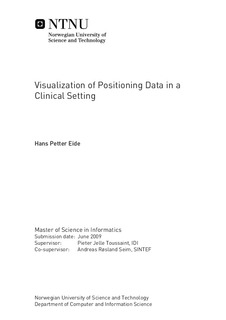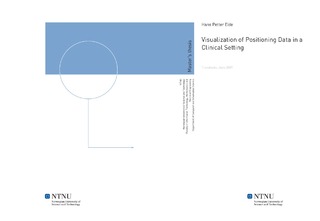| dc.contributor.advisor | Toussaint, Pieter Jelle | nb_NO |
| dc.contributor.advisor | Seim, Andreas Røsland | nb_NO |
| dc.contributor.author | Eide, Hans Petter | nb_NO |
| dc.date.accessioned | 2014-12-19T13:34:01Z | |
| dc.date.available | 2014-12-19T13:34:01Z | |
| dc.date.created | 2010-09-04 | nb_NO |
| dc.date.issued | 2009 | nb_NO |
| dc.identifier | 348813 | nb_NO |
| dc.identifier | ntnudaim:3793 | nb_NO |
| dc.identifier.uri | http://hdl.handle.net/11250/251373 | |
| dc.description.abstract | The use of indoor positioning systems (IPS) is seen as a promising way to support coordination of activities in hospitals. Despite this, little work has been done when it comes to how the data from indoor positioning systems should be visualized to the users. By conducting a case study of a specific work practice at Aker University Hospital in Oslo we have designed visualizations with the aim of investigating the amount of information richness these should have in order to support coordination work. We have also been interested in investigating whether the approach that we have used in this thesis made it possible for the users to use the visualizations in their everyday work, and if it is possible for the users to give informative assessments of them. As little relevant theory exists on how visualizations should be designed we have used methods from the field of usability engineering, and have designed the visualizations as paper prototypes. These have been user tested by test persons with both direct and indirect knowledge about the coordination of activities at the specific work practice. Our work shows that visualizations that had a high degree of information richness were favored. In addition, the possibility to move between different types of visualizations based on the need for information were seen as especially attractive. The test persons that we recruited were able to give informative assessments of the prototypes, but as these were both tailor-made for a specific work practice and tested using simulated scenarios they had a high learning curve. Based on the results from our work we see usability engineering methods as suitable when designing visualizations, although some of them should be left out or modified to fit in with the project in question. | nb_NO |
| dc.language | eng | nb_NO |
| dc.publisher | Institutt for datateknikk og informasjonsvitenskap | nb_NO |
| dc.subject | ntnudaim | no_NO |
| dc.subject | MIT informatikk | no_NO |
| dc.subject | Systemarbeid og menneske-maskin-interaksjon | no_NO |
| dc.title | Visualization of Positioning Data in a Clinical Setting | nb_NO |
| dc.type | Master thesis | nb_NO |
| dc.source.pagenumber | 124 | nb_NO |
| dc.contributor.department | Norges teknisk-naturvitenskapelige universitet, Fakultet for informasjonsteknologi, matematikk og elektroteknikk, Institutt for datateknikk og informasjonsvitenskap | nb_NO |

